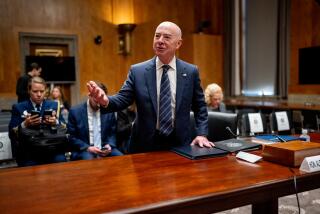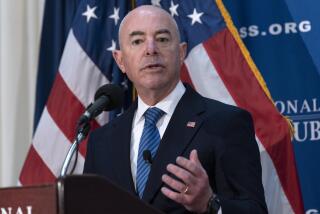A look back at how Clinton’s impeachment trial unfolded
- Share via
WASHINGTON — A generation ago, the Senate considered a question that had not been posed in 131 years: whether to remove a president from office. Just 20 years later, that fraught question is before senators again.
There are key differences between this trial of the impeached President Trump and that of Bill Clinton. In 1999, a Republican-controlled Congress moved against a Democratic president and Democrats decried Republicans’ calls for witnesses. Now the roles are switched. Twenty years ago, both parties in the Senate worked to craft a bipartisan process that would be seen by Americans as fair and credible. That does not appear to be happening today.
A Democratic-led House is battling not only the Republican president, but also the Republicans who run the Senate, with no signs of bipartisan agreement on any of the major disputes. And both sides have attacked the impartiality of the other, and questioned its procedures.
Many are looking to the 1999 impeachment trial as a model, with each side often focusing on the aspects that best fit their positions today.
Here’s a reminder of how that trial unfolded.
Dec. 19, 1998: At the peak of an exceptionally divisive confrontation between Republicans and Democrats, the House approves two articles of impeachment accusing Clinton of lying under oath and obstructing justice in the investigation of his relationship with former White House intern Monica S. Lewinsky. It also designates House managers and notifies the Senate of its actions. (In contrast, House Speaker Nancy Pelosi waited several weeks to name the House managers and forward the two articles against Trump to the Senate.)
Dec. 20 to Jan. 5: A flurry of negotiations between Republican and Democratic Senate leaders ensue over the holidays, including talk of censuring Clinton rather than holding a trial and possibly removing him from office. The two sides disagree over whether to call witnesses, and ultimately opt to wait until after opening arguments from the House and the White House before deciding.
Jan. 5: Senate Majority Leader Trent Lott (R-Miss.) announces Clinton’s trial will begin Jan. 7, but senators continue to wrangle over how long it should be and whether to call witnesses.
House Judiciary Committee Chairman Henry Hyde (R-Ill.), one of the House managers, said they had little idea of what to expect. “Everything is under negotiation. All kinds of rumors are going around. Time is wasting. We need to agree on a format,” Hyde said.
Jan. 6: Representatives and senators return to Washington to convene the 106th Congress, and the House passes a second resolution, to give the House managers authority to act in the new Congress. They again notify the Senate of the impeachment articles.
Jan. 7: Clinton’s trial for perjury and obstruction of justice begins in the Senate with the swearing-in of Chief Justice William H. Rehnquist to preside and of the senators to sit in judgment.
Hyde leads a procession of the House managers bearing the articles across the Rotunda to the Senate and reads them aloud.
Jan. 8: In a closed-door meeting, the Senate unanimously agrees on a process for continuing the trial, but puts off deciding the sticking point — whether to call witnesses.
The agreement gives the House managers and White House lawyers each 24 hours, spread over several days, to make their respective cases. It allows senators 16 hours to ask questions of each side before voting on whether to dismiss the case or to continue and call witnesses.
(The trial rules have not yet been set for Trump’s trial, reflecting the ongoing disputes. The Senate is expected to consider something Tuesday.)
Jan. 11: Clinton’s defense team denies the charges against the president in a 13-page answer to a Senate summons. House managers submit a pretrial memo outlining their case.
(Trump has until Saturday evening to respond to the Senate summons issued Thursday. House managers must also submit their pretrial brief Saturday evening.)
Jan. 13: Clinton’s lawyers file their pretrial brief outlining their case for the president’s acquittal. Clinton tells reporters he wants to focus on the nation’s business, not the trial. “They have their job to do in the Senate, and I have mine,” Clinton says. “And I intend to do it.”
(Trump’s lawyers have until noon Monday to file their brief. The House managers get until noon Tuesday to file a rebuttal.)
Jan. 14: Thirteen House managers begin a three-day opening statement arguing to convict Clinton and remove him from office.
Jan. 19: Clinton’s legal team begins its three-day opening statement. While the lawyers had been expected to call for dismissing the articles, White House Counsel Charles Ruff makes a detailed, point-by-point rebuttal of the case against Clinton, focusing both narrowly on the facts of the Lewinsky scandal and broadly on the Constitution’s standard for impeachment.
“We think there are significant holes in the House case, as well as many overreaching characterizations,” said Jim Kennedy, a Clinton spokesman. “We will challenge the allegations by going through the entire record.”
That evening, Clinton delivers the nationally televised State of the Union address to a joint session of Congress.
Jan. 22: The senators begin questioning the prosecution and defense teams, passing their written questions to Rehnquist.
Jan. 23: A judge orders Lewinsky to cooperate with House prosecutors. She returns to Washington from California.
Jan. 24: Lewinsky submits to a nearly two-hour interview with House managers, who left the meeting saying she is “impressive” and “personable” and “would be a very helpful witness” if she were called. Her lawyers say it produced no new information.
Jan. 25: Senators hear arguments about dismissing the charges against Clinton and then deliberate in secret.
Jan. 26: Senators hear arguments from House managers for seeking depositions from three witnesses — Lewinsky, Clinton confidant Vernon Jordan and White House communications aide Sidney Blumenthal, and then deliberate in secret.
Jan. 27: In back-to-back 56-44 votes, nearly along party lines, the Senate refuses to dismiss the charges against Clinton and agrees to seek depositions from Lewinsky, Jordan and Blumenthal.
Jan. 28: After failing to reach a bipartisan agreement, the Senate approves Republicans’ plan for taking depositions in a party-line vote and sets Feb. 12 as a target date for the trial’s end.
Feb. 1: House managers depose Lewinsky behind closed doors. Clinton’s lawyer reads a statement expressing the president’s regret over what she’s gone through and asks no questions.
Feb. 2: House managers privately question Jordan for three hours.
Feb. 3: House managers question Blumenthal for three hours.
Feb. 4: By a 70-30 vote, the Senate decides not to call Lewinsky to testify in person, as House Republicans wanted, but allows House managers to present video excerpts of her deposition.
Feb. 6: House managers and White House lawyers play video excerpts of Lewinsky’s deposition on large screens set up in the Senate, an unprecedented departure for a body that 20 years later still does not allow the daily use of electronics by senators, staff or press.
House managers argue that the video clips of Lewinsky show that Clinton orchestrated a cover-up of their relationship. White House lawyers call the clips selective and misleading.
Feb. 8: House managers and Clinton’s lawyers offer closing arguments.
Feb. 9: The Senate begins closed-door deliberations on Clinton’s fate after rejecting a proposal to open the proceedings to the public.
“The American people have the right to have a full understanding of how we reached our decisions on this very momentous matter,” Sen. Susan Collins (R-Maine) says before the vote. “It should be debated in the light of day so that the American people and future generations fully understand the reasons for our votes.”
(Collins, still in the Senate, says she is working with several GOP senators to ensure witnesses can be called during the Trump trial.)
Feb. 12:
Clinton is acquitted of both articles of impeachment. On the perjury charge, 10 Republicans and all 45 Democrats vote not guilty. On the obstruction-of-justice charge, the Senate splits 50-50.
More to Read
Get the L.A. Times Politics newsletter
Deeply reported insights into legislation, politics and policy from Sacramento, Washington and beyond. In your inbox three times per week.
You may occasionally receive promotional content from the Los Angeles Times.











